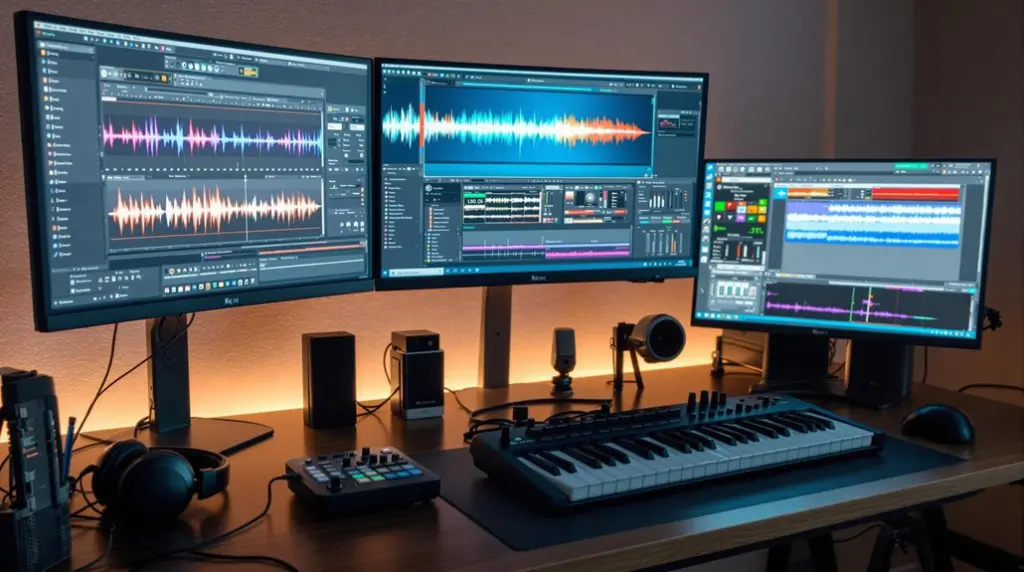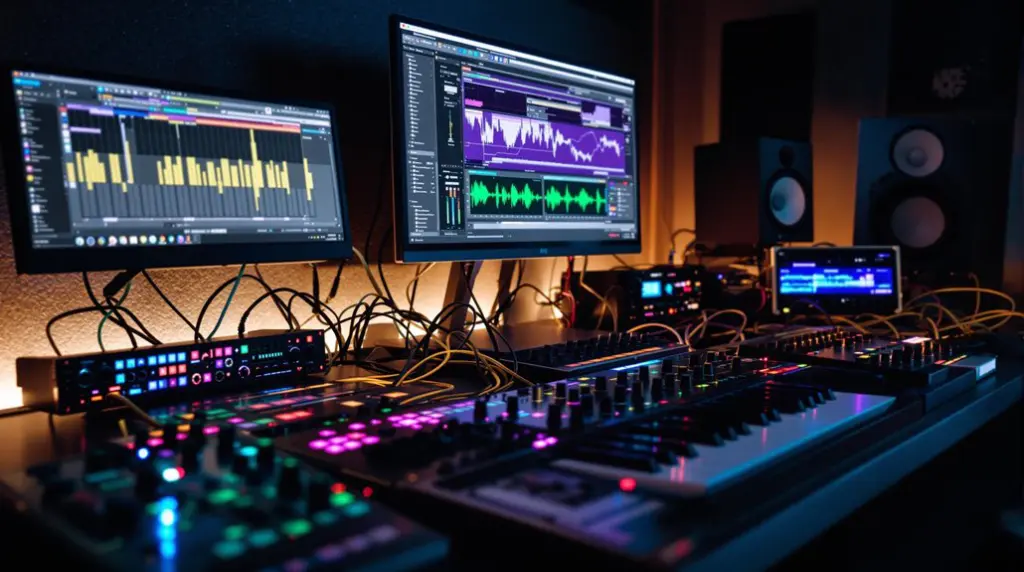The Moog DFAM excels with its impeccably crafted design, ensuring high-end build quality and ease of use. Its drum synthesis features are exceptional, thanks to dual voltage-controlled oscillators capable of producing rich triangle and square waves, complemented by a built-in white-noise source and a classic 24dB low-pass filter for high resonance sounds. Additionally, the DFAM’s intuitive step sequencer with two rows of eight steps allows for precise pitch and velocity control, with manual envelope triggering enhancing creative flexibility. If you’re looking to integrate modular gear and explore extreme sound generation, this instrument offers impressive versatility and performance potential.
Key Takeaways
- Superior build quality with a compact design that fits 60hp Eurorack cases and Moog Mother rack stands.
- Dual voltage-controlled oscillators (VCOs) offering triangle and square waves across ten octaves.
- Built-in white-noise source and a classic 24dB low-pass filter with high resonance for rich sound textures.
- Nostalgic step sequencer with two rows of eight steps for intuitive pitch and velocity control.
- Extensive modulation options, including independent VCO pitch modulation and manual envelope triggering for creative performance.
Design and Build Quality
The Moog DFAM stands out with its meticulously crafted design and superior build quality, essential traits for any high-end synthesizer. Its compact dimensions allow it to fit seamlessly into a 60hp Eurorack case or Moog Mother rack stands, providing excellent integration capabilities with other Moog units.
This thoughtful design choice not only enhances the aesthetic coherence of a modular setup but also maximizes workflow efficiency. The high-quality finish of the DFAM is immediately noticeable, with smooth knobs that offer precise control and a spacious layout that guarantees an engaging user experience.
The interface is remarkably user friendly, making it accessible for both beginners and seasoned sound designers. Similar to how Phatool engages fans through social media, the DFAM’s layout facilitates quick adjustments and creative experimentation without a steep learning curve.
On the practical side, the back panel includes essential connectivity options such as a quarter-inch audio output and a 12V power supply socket. This minimalistic yet functional approach guarantees that the DFAM can be easily incorporated into a variety of audio setups.
Additionally, its identical dimensions to the Mother-32 allow for seamless racking, which is a significant advantage for users looking to expand their modular synthesizer systems.
Drum Synthesis Features
When delving into the drum synthesis features of the Moog DFAM, one immediately notices the distinct versatility afforded by its dual voltage-controlled oscillators (VCOs). These VCOs, capable of producing both triangle and square waves, span an impressive pitch range of approximately ten octaves, providing a solid foundation for creating a wide array of percussive sounds.
The inclusion of a built-in white-noise source further enriches the sound texture, offering an additional layer of complexity and depth. This noise source can also be substituted with external audio for more experimental modulation possibilities. Similar to the Novation Launchpad Pro MK3, the DFAM’s advanced features considerably enhance creative workflow and sonic exploration.
Central to the DFAM’s drum synthesis capabilities is its classic 24dB low-pass filter, renowned for its high resonance and self-oscillation properties. This filter is pivotal in the process of tonal shaping, allowing users to sculpt their sounds with precision and creativity, from sharp, piercing tones to warm, resonant basses.
The ability to independently modulate each VCO’s pitch and utilize built-in modulation routing—where VCO1 can modulate VCO2—enables the creation of intricate and dynamic drum patterns. These features collectively make the Moog DFAM a powerful tool for generating unique and engaging drum sounds, ensuring it stands out in any sonic landscape.
Sequencer and Modulation
Nestled at the heart of the Moog DFAM is its nostalgic step sequencer, a key component that offers both a retro charm and robust functionality. The sequencer features two rows of eight steps each: the top row controls pitch while the bottom row governs velocity, providing enhanced dynamics and expressiveness in sound design.
Despite its fixed step count, which limits it to eight steps and lacks dynamic pattern length variation, the sequencer’s simplicity is part of its allure. Leveraging critical listening while programming the sequencer can help in identifying nuances that enhance the overall sound quality.
The DFAM’s sequencer is equipped with a tempo range spanning from a leisurely 10 bpm to a blistering 10,000 bpm, facilitating extreme sound generation and even reaching audio rates for unique waveform processing. This versatility in tempo manipulation allows for a broad spectrum of rhythmic possibilities and experimental soundscapes.
Additionally, the sequencer can be manipulated using CV input, enabling intricate tempo adjustments that integrate seamlessly with other modular gear. For synchronization with external devices, the ADV/Clock input is available, allowing the DFAM to follow an external clock.
However, it is important to note that the tempo knob and CV input become redundant when the unit is slaved. Manual envelope triggering further enhances creative performance capabilities, making the DFAM an indispensable tool for innovative sound design.
Frequently Asked Questions
Does Moog DFAM Have Midi?
The Moog DFAM lacks MIDI connectivity and does not feature MIDI capabilities. Instead, it focuses on analog sound creation and relies on its internal sequencer and external clock synchronization for integration with other devices.
How Does the DFAM Work?
The DFAM employs advanced synthesis techniques through its dual VCOs, step sequencer, and 24dB low-pass filter, enabling intricate sound design. The modular patchbay and internal noise source further enhance its versatility for creating dynamic, evolving sounds.
Is the Moog DFAM a Drum Machine?
The Moog DFAM is not a traditional drum machine; rather, it excels in drum synthesis and sound design, offering extensive modulation capabilities and a nostalgic step sequencer for creating unique, hands-on analog percussion sounds.
What Size Is the Dfam?
The DFAM dimensions are compact, fitting into a 60hp Eurorack case, which enhances DFAM portability. This design guarantees seamless integration with other Moog units while maintaining robust build quality, ideal for both studio and live environments.
Conclusion
The Moog DFAM stands out due to its exceptional design and build quality, advanced drum synthesis capabilities, and versatile sequencer and modulation options. Its robust construction guarantees durability, while the synthesis features provide a wide sonic palette for creative exploration. The sequencer and modulation functionalities offer extensive control and flexibility, making the DFAM a highly valuable tool for sound designers and musicians seeking to push the boundaries of rhythmic and percussive synthesis.




